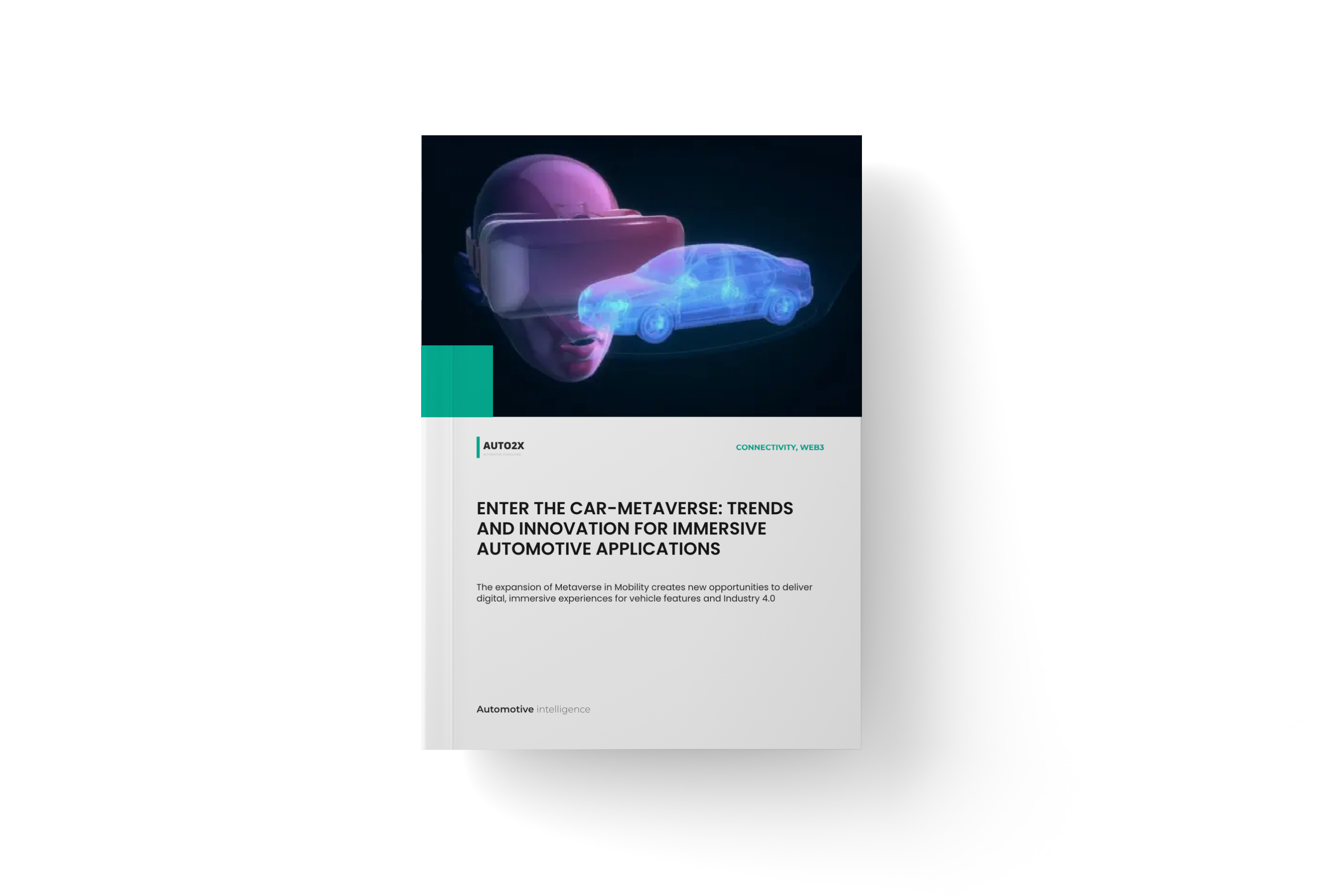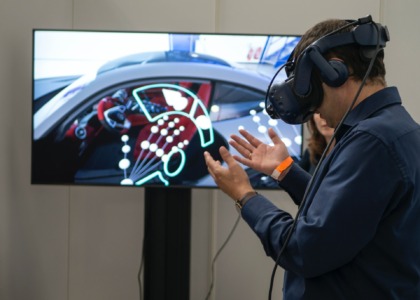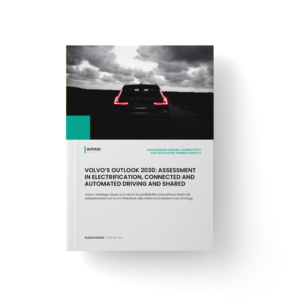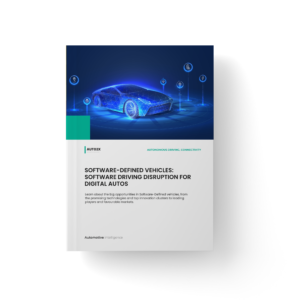Description
The expansion of Metaverse in Mobility creates new opportunities to deliver digital, immersive experiences for vehicle features and Industry 4.0
The Metaverse, the virtual worlds which revolutionized gaming, are coming to vehicles promising immersive reality.
This report examines:
- New applications enabled by the progress of Car-Metaverse. We examine vehicle interior features, remote services and adjacent industry applications such as financial services and robotics.
- New business models in Automotive Metaverse: from expansion of automotive players into new verticals, to new entrants, and Metaverse-as-a-Service
- Innovative companies behind core technologies, such as XR, holography, connectivity.
Auto2x segments Automotive Metaverse into 20 applications
- Vehicle in-cabin applications and features
- Social media: embedded or integrated with social media.
- Example Meta’s XR headset in vehicles
- Safety: cabin sensing, e.g. Mercedes-Benz’s Brain-to-Machine interface in the 2021 concept VISION AVTR
- Autonomous Driving: tele-operation of robotaxis
- Connected: virtual office inside the vehicle, or the Vehicle-as-a-Service, aka Vehicle-as-an-Office
- Information:
- Real-time information,
- Avatars, assistants
- Augmented Reality Windshield
- Entertainment: gaming, e.g., Holoride’s VR headset that merges vehicle data to make gaming immersive
- In-car e-commerce
- Electrification
- Maintainance: using vehicle digital twins
- Social media: embedded or integrated with social media.
- Vehicle remote access or tele-operation
- Emergency services
- Remote operation of vehicles
- Virtual development, prototyping
- Remote experiences, such as training
- Dealership services:
- Virtual showroom, virtual dealership,
- Financial services
- Industry 4.0:
- Smart Factory, from Renault
- Robotics, from Hyundai

CarMetaverse web search hype is slowing down, but carmakers’ activities are surging
What is the Metaverse? That was actually one of the top searches on the web in the end of 2021 according to Google Trends, followed by the renaming of Facebook to Meta in October 2021 and the AR / VR focus in CES 2022.
However, since then, the search interest has droppped mainly due to the criticism of Meta’s metaverse strategy, the cost of hardware and other technological hardles, as well as the lack of consumer interest.
Metaverse describes virtual, digital worlds which provide immersive reality experiences for online communities powered by the creator economy. Today, it is more prominent in gaming, (e.g. Fortnite), social media (AR), with the creation of avatars, tokens and more, but it is quickly expanding to other industries, such as Social Media, with Meta’s (ex-Facebook) interest, media, sports, automotive and others.
Metaverse is part of the Web3, the next generation of the worldwide web. Web2 is based on cloud storage, mobile computing and apps. Web3 is more decentralized, local, shifts the value to the creator economy, privacy and ESG.
Car-Metaverse enables in-cabin, remote and virtual development features for immersive-reality experiences
Carmakers are embracing XR (extended reality with VR or AR) and expirement with applications.
Through Metamobility, robots will help people overcome the physical limitations of time and space, providing a means for connecting and interacting in the metaverse. Hyundai Motor envisions a metaverse using robots as a medium between the real and virtual worlds, enabling people to actually change and transform things in the real world through a metaverse and robot connection. Hyundai, CES 2022
Key Car Metaverse activities from carmakers, 2019-2023:
- At the 2019 Tokyo Motor Show, Nissan unveiled VR passengers to keep drivers company in autonomous cars during long journeys.
- In 2020, KIA launched a VR showroom to showcase the models of new vehicles to their customers.
- In January 2022, Hyundai unveiled its concept of “metamobility”, which combines robotics and metaverse
- From June 2022, selected Audi models which integrate holoride’s VR glasses can access games, films, and other interactive content.
- In September 2022, Ford filed 19 different trademarks related to metaverse
- In November 2022, Renault Group launched the “first industrial Metaverse” which digitalizes production allowing metaverse control. Each factory has its replica in the virtual world using Digital Twins which allows digital supervision and control in real time. The Group expects that by 2025, it will enable €320m in various savings.
- In December 2022, Fiat, part of the Stellantis Group, launched its first metaverse store / showroom allowing potential customers to take a virtual tour of one of its cars and test drive them on a virtual course.
- Honda is utilizing VR in its development of future vehicles.
- In January 2023, BMW debuted “i Vision Dee,” a metaverse car that symbolizes the brand’s vision of digital mobility in the future.
- In January 2023, Skoda unveiled a virtual way for audiences to explore Škoda with the Škodaverse.
- In January 2023, Mercedes-Benz submitted trademark applications for its vehicle line-up to future-proof its expansion to the metaverse
- Mercedes-Benz is also using the Nvidia Omniverse platform to design and plan manufacturing and assembly facilities.
- Maruti announced the Expoverse, its third attempt at creating a metaverse environment for its users
- MG Motor launched MGverse, a platform built in partnership with metaverse environment platform Metadome
- Volkswagen and Microsoft collaborate to use HoloLens 2 mixed reality headset in a moving vehicle to improve user experience
“A virtual trip to the Škodaverse allows fans and visitors to learn more about our brand and establish an even stronger bond with it. By joining the Metaverse, we are taking a proactive approach towards new technologies to remain innovative and maximise our appeal to a younger customer demographic – in line with our Next Level – Škoda Strategy 2030.” Martin Jahn, Škoda Auto Board Member for Sales and Marketing
Apart from carmakers, start-ups are launching car services.
- holoride, a German spin-off from Audi, offers aftermarket and retrofit VR that syncs with vehicle movements to provide immersive in-car gaiming.
- WayRay, a company specializing in holography and AR, unveiled a “concenpt car designed around True AR™ technology and a new ride-hailing business model”.
- Taiwanese start-up Mindtronic AI unveiled its biometric sensing technology with a Meta-service ecosystem for the future of mobility
“We took relevant data points like location, speed, steering, acceleration and braking – and matched these with artificial environments. By doing so, we not only created a perfectly motion-synchronized journey through virtual worlds, but something radically new that entertains backseat passengers in an unseen way,” says Nils Wollny, co-founder and CEO of holoride.
Customers can also benefit from enhanced product experiences. Full-fidelity, real-time car configurators, 3D simulations of vehicles, demonstrations in augmented reality and virtual test drives all help bring the vehicle to the customer. NVIDIA
XR investment is gaining traction
Investment bank Goldman Sachs predicts that the Metaverse is a $8 trillion opportunity, across automotive, gaming, eduction, retail, work, media and other industrties. The market size for XR alone, a core technological enabler, is expected to grow from $16 billion in 2021 to $45B in 2026.
Venture capital investments made into VR/AR start- ups in 2021 amounted to $3.9 billion, according to a report by McKinsey.
“Gaming already accounts for the largest share of consumer spending on AR/VR, with over $3 billion in spending worldwide in 2020, according to a relevant report.
Metaverse technologies still face technological challenges
Infrastructure and technology challenges, such as the cost and integration of XR, advancements in spacial computing and holography and ubiquitous connectivity without latency, are some of the key technological challenges this domain faces.
- Spatial computing interprets physical space and introduces virtual 3-D objects, allowing users to interact with environments that feature virtual elements.
- XR either blends reality (AR-Augmented Reality) or replaces it (VR-Virtual Reality). Today, XR headsets for consumer electronics suffer from limited battery life, weight, and ergonomics.
- Finally, as the adoption of 5G rises, it will enable lower latency and better accuracy.
- Interoperability of digital platforms and scalability are other challenges to overcome.





